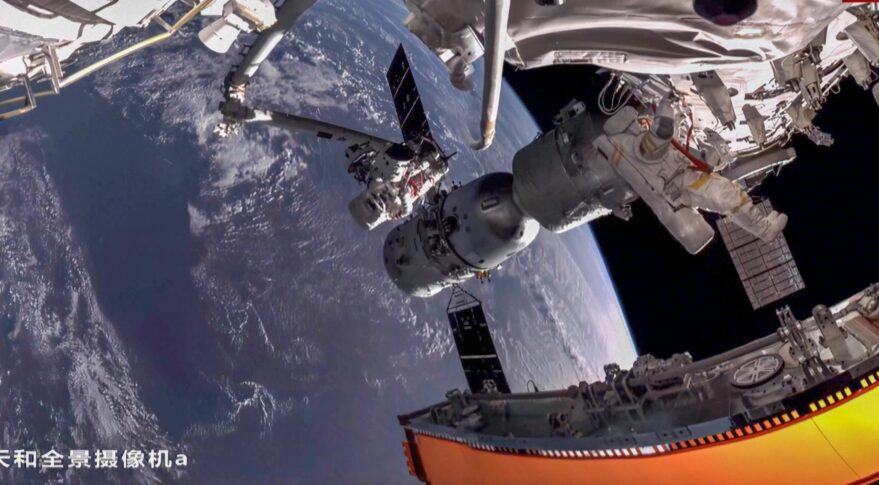
Chinese official calls for protection of space assets, international coordination mechanisms (Image Credit: Space News)

HELSINKI — China needs to accelerate the development of space asset protection policies and related international coordination mechanisms, according to a space industry official.
“We should proactively promote the formulation of space asset protection policies, so that space asset protection activities can be based on the law, and at the same time declare the importance that China attaches to space asset protection,” Yang Mengfei, an academician at the China Academy of Space Technology (CAST), told China National Radio.
Yang also called for establishing a coordination mechanism between China’s space agencies and other national level agencies, to communicate the orbits and deployment plans of megaconstellations and collision warning information.
Last year China informed the United Nations that its crewed space station twice maneuvered to avoid what it described as potential collisions with SpaceX Starlink satellites. U.S. views on the incidents differed from China’s account.
“While sharing information about conjunctions is important, it is also increasingly important to have some sort of agreement about what level of risk is acceptable,” Victoria Samson, Washington Office director at the Secure World Foundation, told SpaceNews.
Other measures proposed by Yang were construction of a space debris environment monitoring system and the acceleration of projects such as space debris removal.
These include making up for the “lack of ground-based observation capability with space-based” capacity and quickly forming a monitoring capability for centimeter-level space debris.
Ground-based radar, optical telescopes and laser systems are employed variously by entities across the world to detect, track and catalog objects larger than five to 10 centimeters in low Earth orbit by a number of groups, but reliably tracking smaller objects is very challenging. LeoLabs in 2021 set up a phased-array radar facility in Costa Rica to begin tracking objects as small as two centimeters.
The European Space Agency’s Space Debris Office estimates there are 36,500 objects in orbit greater than 10 centimeters and 1,000,000 objects from greater than one and up to 10 centimeters.
This proposed boost in China’s space situational awareness (SSA) capabilities would also help with the second proposal on active debris removal (ADR), says Samson.
China launched a “space debris mitigation satellite” and towed a defunct Beidou navigation satellite from a geostationary orbit into a higher, “graveyard” orbit out of the way of operational spacecraft.
Yang was speaking to the media in his role as a deputy to the National People’s Congress, the legislative body which forms part of China’s ongoing annual political sessions in Beijing.
The proposals follow a strong acceleration in China’s orbital launch rate over the past decade and large increase in the number of operational spacecraft, now including a crewed space station. The China National Space Administration (CNSA) established its Space Debris Monitoring and Application Center in 2015, at the National Astronomical Observatory of the Chinese Academy of Sciences.
“Generally speaking, these seem like adaptations to a more complicated space environment, which makes sense,” says Samson. “But in that case, it’s also important to be as transparent as possible so that there isn’t inadvertent escalation or perceptions that these capabilities are intended to be offensive in nature.”
The interview with Yang apparently did not touch on other aspects of spacecraft security, such as rapid-response launch and protecting against cyber attacks.
Yang belongs to CAST, a major spacecraft maker under the country’s state-owned main space contractor, the China Aerospace Science and Technology Corporation (CASC). He notes that as China’s space assets are growing rapidly, they also face a series of security risks such as approaches by spacecraft from other countries and the collision threat from space debris.
“Last year, as you may have noticed, our space station was approached by two [SpaceX] satellites while in orbit, and also faced the risk of space debris collisions. So in this context, as the number of our satellites increases, it is increasingly important and urgent to protect space assets,” Yang said.
The number of Chinese satellites operational in orbit is expected to exceed 400 in 2022, according to the CNR report. China’s main space contractor CASC aims to launch at least 140 spacecraft across more than 50 launches this year alone, including six missions to complete its modular space station.
“In the future, as our national space industry develops, the number of spacecraft will increase and the risk of collisions will become greater,” Yang Mengfei said.
SpaceX and OneWeb are just two of a number of companies planning constellations consisting of tens of thousands of satellites in LEO. China has also filed plans for a 13,000-strong national LEO satellite internet megaconstellation, while new commercial companies are also working on remote sensing and IoT constellations.








